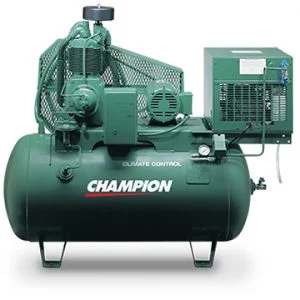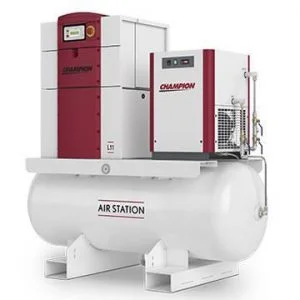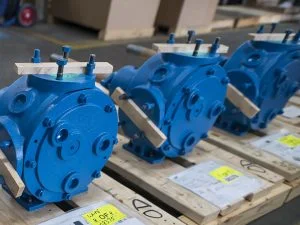
A lot of workshops and ‘less complicated’ compressed air systems owners often face a variation on which compressor option should we take?
The choice is between:
Installing a single big air compressor that can deal with the peak load of the system (as well as future increases in demand)?
Or
Installing two compressors that have the same total output as the larger one but will have a lower power demand while they are unloaded.
To be fair when you buy an air compressor you are guessing or modelling what you think your future demand for compressed air will be over the life of the compressor. Which is not an easy task. Think about the money the National Weather Service spends trying to forecast tomorrow to get it wrong…
There are other options too such as a Variable Speed Drive or modulating inlet air compressors… as well as system design features like storage tanks.
The Best Choice of Air Compressor Depends on Your Duty Cycle
Just in case – duty cycle is the amount of time it needs to be running at full capacity. The rest of the time it is running unloaded. So 60% duty cycle means your air compressor will run at full capacity 60% of the time and be unloaded the remaining 40%.
However it will turn on and off based on the demands of your compressed air appliances. So if you need a series of air tools to run 10 hours a day then the demand is fairly constant. However if you are using your compressed air to propel abrasives, the demand will spike while you’re blasting but the rest of the time your compressed air needs might be minimal.
Both scenarios could see a 60% duty cycle for a given air compressor… but you will find the dynamics of your duty cycle will influence your best choice.
As a rule when you have continuous demand you are better off taking the larger compressor that delivers the volume of air you need at the desired pressure.
However when faced with demand that spikes you might find that running two 25hp compressors instead of purchasing a single 50hp compressor will be more energy efficient. It means you’ll still be able to meet peak demand but you’ll consume less power while your compressors are idle or your compressed air consumption is low enough that a single compressor can fulfill the demand, then the second compressor can provide the additional air when it’s needed.
This sort of lateral thinking is necessary when you are looking to buy your next air compressor(s). Power consumption represents up to 75% of the total cost of ownership of an air compressor while the purchase price is usually 10-15%. It can make sense to invest a little extra up front to slash your power bills.
If you are looking for a collaborative approach to getting a more efficient compressed air system then contact the team at Pye-Barker on 404-363-6000 or drop us a line sales@pyebarker.com and we can help find the right compressor solution for your situation.

If your air compressor comes on for a short burst then turns itself off… then starts cycling again your compressor is short cycling… We’ve just been through this problem with a couple of clients and I feel it’s important to share this with you.
Short Cycling is *almost* always a symptom of a deeper problem in your compressed air system. It is important that your technician finds the root cause – you need to know why and fix it. While your air compressor short cycles, you are paying a 20%-50% premium for compressed air. It becomes imperative for a well-run plant to find that cause and fix it.
On top of the premium you are paying for compressed air, if you haven’t already had them, there are big repair bills on their way if your compressor continues to short cycle, followed by a bigger bill for a new air compressor. The only way to prevent this is to find that root cause of the short cycling and get it fixed.
So I thought I’d share with you 3 of the most common causes of air compressor short cycling.
Lack of an operation time delay: At Pye-Barker, we reckon that that is arguably the most common cause of a short cycle. A proper time delay can keep the system from running due to discharged air still circulating in the system immediately after its operation. It can allow the pressure controller to reset itself naturally while not calling for cooling as opposed to firing another cycle based on high pressure triggers due to compromised condensers.
Pressure or temperature control differential is too small: When the pressure controller’s low pressure differential is set too tight, it can cause the compressor to short cycle. When your temperature and pressure differential is too small you’ll take longer to achieve set point and use more energy use in the process.
A Dirty condenser: A dirty condenser limits your system’s ability to reject heat for regulating temperatures and pressures needed for cooling which can lead to compressor tripping on high head pressure.
Having monitoring systems in place, especially electronic monitoring with data sent to a control room, makes it much easier to spot if any of your compressors are short cycling and act. With a manual maintenance system a short cycling air compressor isn’t necessarily as obvious.
If you spot your air compressor short cycling – get your maintenance crew on to find the underlying cause of the problem post-haste. Or give us a call at 404-363-6000. We would be happy to have one of our technicians come out and help you with your challenge.
Imagine having a raw material that is 78% pure and there is no royalty, lease or other fee associated with extracting it.
Why on earth would you go and buy a refined version of the raw material at $5 to $17 per m3? The only reason I can think of is that you never thought to extract it yourself.
I’m talking about Nitrogen gas. It makes up 78% of the atmosphere. With a simple on-site generation system, you can make your own with the purity you specify, test it for purity, and store it ready for use, at a cost in the range of 40-80% of buying it in from a gas supplier.
No more relying on bottle banks or bulk gas shipments. Just make your own at $3 per m3.
Obviously generating your own nitrogen gas isn’t the right choice in every situation.
When not to make your own.
When you switch from buying to producing nitrogen, you’ll obviously be buying a nitrogen generation system. This means you’ve got more equipment to monitor and maintain. In an ideal situation you’d want to be sure that your existing maintenance team can handle the extra little bit of overhead.
Then in order to make this a really viable transition, you’ll need to be sure that the savings from producing your own Nitrogen pays for the generation system in an acceptable time frame and then puts you squarely ahead on the financial statement. After all, your only ongoing costs for Nitrogen at this point are maintenance and power.
For smaller users of nitrogen, upfront investigation is required to see what your particular capital investment and time to pay off would be.
When to make your own.
If you are using large quantities of gas and can handle the minimal extra overhead of maintaining a nitrogen generation system then you are going to be able to slash your nitrogen costs by at least 40% but possibly all the way up to 80%.
It’s a very simple business case but as always, it’s best to work through this on a case by case basis.
If you need help reviewing if you should switch to Nitrogen generation from supplied gas then give the team at Pye-Barker a call on 404-363-6000 or drop us a line sales@pyebarker.com and we can help guide you to the right answer for you.

Bill Hewlett (Founder of HP)
My favorite story about this idea comes from Federal Express. Just after they’d started they had a problem with the night shift. It was always finishing 2 hours late. Didn’t matter how many people they put on, who they fired, motivation techniques anything… Management was fed up. They needed the night shift to be finished on time.
It took months to figure this out, but eventually they chanced upon the idea of paying a flat rate to the workers on the night shift instead of hourly. Low and behold – the night shift finished two hours early, every night.
Most of our pump customers run preventive maintenance (PM) and condition-based maintenance (CBM) programs. Some are little less formal about it but still have strong maintenance programs.
What varies is the reported return on investment of these programs.
While some of our clients think they have gotten a significant return on their investment, others feel that CBM programs in particular are not delivering a high enough return.
After exploring this with clients I can say that culprit number one is the selection of maintenance metrics.
A bit of backstory – while we do our best to discourage this behavior, a lot of the CBM shutdown and alarm values are based on the equipment manufacturer’s specifications. Those values are not ‘universally correct.’ What’s best varies plant to plant, company to company. Perfect for one is a recipe for disaster for another.
So what we see are shutdowns that shouldn’t be happening. This is causing productivity losses which are counting against the return of a site’s maintenance programs. What’s obviously frustrating is that people ‘just doing their job’ are costing the plant valuable productivity.
This is why performance standards, alarm values and shutdown values need to be determined as part of the predictive maintenance program. Not just taken from an instruction manual.
In order to get return on your PM and CMB programs you need
Then you have a winning maintenance program. Use the manufacturer’s metrics as a baseline but don’t be afraid to adjust them to fit your circumstances.
If you are having any trouble with your pump maintenance programs, please get in touch with us. We can advise you on the likely impacts that changing your maintenance metrics will have on your existing pumps and processes. Give the team at Pye-Barker a call on 404-363-6000 or drop us a line sales@pyebarker.com and we will get your questions answered.


